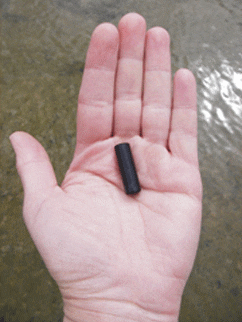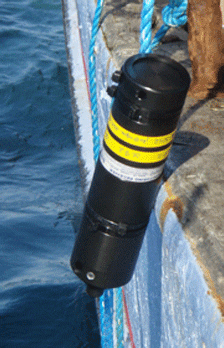When PhD student Junita D. Karlsen from DTU Aqua plotted the geographical positions of 15 acoustically tagged cod on a map, the cod’s positions formed a perfect silhouette of a shipwreck. This surprised her - not because the cod were located at a shipwreck, as it is well known that cod often gather at wrecks, but because her results show that the same cod return day after day to the same wreck and therefore can be said to have ‘their own’ local wreck.

"It is surprising that the cod return to the same wreck because they are highly mobile and can swim several miles a day. And of course the size of a shipwreck is very small relative to the area the cod could move around in," says Junita D. Karlsen, who on 12 April defended her thesis entitled: ‘Hot on the tail of hefty Atlantic cod: an interdisciplinary study on the behaviour at shipwrecks in the North Sea'.

In her work on the project, Junita D. Karlsen studied adult cod behaviour on shipwrecks in the central North Sea by tagging cod with so-called acoustic tags and by analysing the stomach contents of cod that were caught at shipwrecks. Her research reveals that adult cod are stationary, thereby contributing important new knowledge that can be applied in the management of North Sea cod.
Detective work in a thousand cod stomachsIt took Junita D. Karlsen two years to collect data on the behaviour of cod around the shipwrecks. Over the two years, she examined the stomach contents of over one thousand cod in order to find out what cod eat and where they catch their food. In addition, and with the aid of only a fishing rod, she captured about 140 adult cod, which she tagged with acoustic tags. Then she let them go again. And then the tags yielded valuable information on the cod’s comings and goings.

"The acoustic tags work by sending sound signals that are detected and stored by acoustic receivers, which I set up around different wrecks," says Junita D. Karlsen, who placed the acoustic receivers around 10 shipwrecks in the central North Sea and then left them to accumulate data about the location of the cod.
Costly to switch wreckThe results show that individual cod has its own local shipwreck, which it sticks to despite the fact that it could easily move much further afield every day. Junita D. Karlsen believes that it is advantageous for cod to stay at the same wreck, because it then gets to know the area around the wreck well:

"Because a cod knows the area around its 'own' wreck, it can exploit, for example, feeding sites and protective cover in the area more effectively. If the cod switched wreck, it would expend a significant amount of energy finding a new wreck or similar structure and then getting to know the new area."
Cod shelter from the current Data from the tagged cod revealed that about one third of the cod spent more than 80 per cent of their time in 'their' shipwreck.
"Maybe it sounds a bit boring for the cod to spend most of their time in one place at a wreck, but the data strongly suggest that cod are using the wreck as shelter from the current. In that way the cod save energy which they can use to grow and reproduce," says Junita D. Karlsen.
When Junita D. Karlsen looked more closely at the acoustic data, she discovered that some of the cod leave the wreck during the day, while others leave it at night. To find out what the cod do when they leave the wreck, she examined the stomach contents of cod caught at shipwrecks. This revealed that cod eat different prey at different times of the day. Moreover, the kind of prey consumed showed that the cod had not caught them at the wreck. Junita D. Karlsen was then able to conclude that cod forage for food when they leave the safe environment of the wreck:
"There are certain animals which are associated with a shipwreck, and the prey I found in the cod’s stomachs do not live on shipwrecks. So when cod have moved away from the wreck, it has been to find food," says Junita D. Karlsen.
The cod had eaten mainly swimming crab, masked crab, dab, sand eel and a type of marine worm called a sea mouse. These are all animals that live on sandy sea beds and not on shipwrecks.
Cod stocks in the North Sea have been low for many years, and especially the large cod play a crucial role in reviving these stocks. This is because large cod produce both more and larger eggs, which are of a higher quality than eggs from smaller cod. And this means that research into the behaviour of large cod is very important.
"Knowledge about the large cod’s behaviour is important in order to be able to look after them as well as possible in periods when stocks are low. This will then increase the chances of there being more cod in the North Sea in the future," says Junita D. Karlsen.


